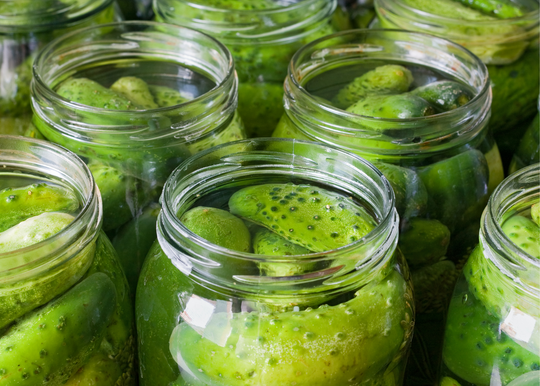Pickled Cucumbers, Two Ways

Vinegar Method:
3 cups water
2 cups white vinegar
⅓ cup kosher salt
¼ cup sugar
About 5 cloves of garlic, or to your taste
2 Tablespoons dill seed
1 bunch fresh dill
2 bay leaves
Pinch of chili flake, to your taste
Combine all ingredients and bring to a boil, then remove from the heat. Steep 5 minutes to cool slightly, then pour over the cucumbers (straining if desired). Cool to room temperature, then refrigerate. Make sure they are completely submerged. You may keep these cold until ready to eat. These will last quite a while in your fridge, but the Health Department dictates that, as cooked food, they must be eaten within 7 days.
Fermented Method:
2 tablespoons plus 2 teaspoons kosher salt per liter of water
½ head of garlic
¼ tsp chili flake, or to taste
2 bunches dill, or sprouting/flowering dill if available
Horseradish leaf, oak leaves, cherry leaves, or a tiny bit of black tea (optional)
Place the washed cucumbers and all ingredients in your container. Dissolve the salt in the water, then pour the brine over. The tannin in the leaves act to keep the cucumbers crunchy. You could also try adding some carrot slices or even green banana peel… there are lots of superstitions around crunchy cucumbers. Regardless, move these to a cool, dark place. Keep them submerged and loosely covered. Visit them every couple days and remove any white mold or scum you see on the surface of the brine. This is not dangerous, but if you see black or brown mold, you should discard them. Taste the brine after about a week. The pickles will taste like the brine for the most part. You can allow them to sour as much as you like. This concentration of salt will produce somewhere between a “half sour” and “full sour” pickle. Once soured to your liking, store them in the refrigerator to effectively stop further fermentation. You can also can these, but I’m not describing that process here. Either way, these last a very long time and are very healthy for your gut biome!
